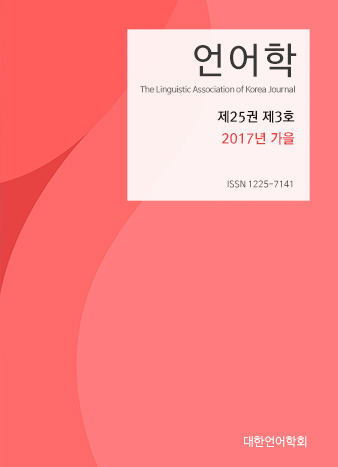대한언어학회 전자저널

25권 3호 (2017년 9월)
- 새로운 한국어 존대 종결 어미 사용 양상
-
안정근
Pages : 173-192
Abstract
Ahn, Jeong Khn. (2017). The use of new forms of honorific final ending in Modern Korean. The Linguistic Association of Korea Journal, 25(3). 173-192. This study examines new forms of honorific final ending which have emerged in recent years in Modern Korean such as -ta-yo, -haca-yo, and -ha-si-keyss-supni-ta. -ta-yo is mostly used by young girls as an honorific final ending towards the adults, particularly the intimate ones including their parents and teachers. It is often used by their female teachers as well towards the intimates as a linguistic mechanism to lessen the awkwardness when they boast of something or try to become more intimate relation with them. -haca-yo is generally used by young adults particularly on SNS (Social Network Service) when they ask, advise, recommend, or suggest others on the Net to do something together. -ha-si-keyss-supni-ta is used usually by a person in authority in places such as school and church when he/she encourages, asks, advises, or recommends others to fulfill a promise or commands. As indicated, these new forms of honorific final ending in Modern Korean are exclusively used by some particular groups, i.e. -ta-yo by young girls and their teachers, -haca-yo by young adults, and -ha-si-keyss-supni-ta by a person in authority, showing the politeness in language use towards others. They are often treated as wrong honorific final endings in Korean but there still is a possibility or potential for them to become right honorific ones sometime in the near future as witnessed in other Korean words such as sakulsey (monthly rent) once treated as a wrong word but finally acknowledged to be right ones.
Keywords
# 존대법(honorifics) # 최근 한국어 존대 종결 어미(honorific final ending in Modern Korean) # 존댓말(politeness in language use) # 다요(-ta-yo) # 하자요(-haca-yo) # 하시겠습니다(-ha-si-keyss-supni-ta)
References
- 개그콘서트. (2013). KBS 2TV. 2013. 9. 1.
- 교육과학기술부. (2007). 유치원 교육과정 해설 I, II, III. 교육과학기술부.
- 김명순, 강옥경, & 임양미. (2008). 유아의 존댓말 사용과 어머니의 인식 간의 관계. 유아교육연구, 28(5), 273-293.
- 김세원. (2009). 초등학생 높임법 사용 실태 분석을 통한 지도 방안 연구. 석사학위 논문. 부산교육대학교.
- 김영일. (2016). 청자 존대 ‘-시-’의 종합적 검토. 언어과학, 23(1), 53-87.
- 김영주. (1994). 높임말 사용의 지도. 초등국어교육, 4, 27-50.
- 김은혜. (2016). 한국어 선어말어미 ‘-시-’의 사물 존대 기능: 백화점, 대형마트, 재래시장 판매원의 발화를 중심으로. 사회언어학, 24(1). 91~113.
- 김진희. (2001). 초등학교 아동의 대우법 지도 방안 연구. 초등 국어교육, 11, 103-130.
- 네이버블로그. (2016). 슈쿤’s 제주 섬나라 적응기, 나는야 윤후 엄마, 핑쿠핑쿠해.
- 네이버카페. (2016). 퍼플맘의 스마트 육아.
- 목정수. (2013). 선어말어미 ‘-시-’의 기능과 주어 존대. 국어학, 67, 63-105.
- 민지혜. (2014). ‘-시-’의 확대 사용 양상에 대한 문법 교육적 연구: 서비스 업종의 담화 분석 내용을 중심으로. 석사학위 논문. 이화여자대학교.
- 박석준. (2004). 선어말어미 “-시-”의 문법외적 용법에 관하여. 한말연구, 14, 201-220.
- 박진이·김민진. (2010). 만 3, 4, 5세 유아의 존댓말 습득에 관한 연구. 아동학회지, 31(6), 153-166.
- 백수연. (2016). 한국어 주체존대 선어말어미 ‘-시-’의 공손 전략과 그 유용적 확장: 판매 담화 분석을 중심으로. 한국언어학회 2016년 겨울학술대회 발표논문집, 99-110.
- 이귀옥. (1997). 유아의 언어적 특징과 교수법: 존대법 습득 현황 조사. 언어연구, 1, 23-36.
- 이래호. (2012). 선어말 어미 ‘-시-’의 청자 존대 기능에 대한 고찰. 언어학연구, 23, 147-166.
- 이순형. (2001). 한국 아동이 초기에 획득한 문법적 형태소의 종류 및 획득 시기. 아동학회지, 21(4), 1-18.
- 이정복. (2010). 상황 주체 높임 “-시-’의 확산과 배경. 언어과학연구, 55, 217-246.
- 임동훈. (2011). 담화 화시와 사회적 화시. 한국어 의미학, 36, 39-63.
- 임철순. (2013). [임철순의 즐거운 세상] '~하실게요'라고 말하지 말라. 한국일보. 2013. 10. 7.
- 카카오톡. (2016). 김샘방, 중딩방, 여친목방, 남친목방.
- 허철구. (2016). [우리말 톺아보기] 하실게요. 한국일보. 2016. 7. 4.
- Choi, I. (2004). Partial honorific agreement in Korean. The Linguistic Association of Korea Journal, 12(2), 207-225.
- Cool messenger. (2016). A 중고등학교 교무실.
- Home. (2015). Movie. Dreamworks production.
- Kim, Y. J. (1997). The acquisition of Korean. In D. Slobin (Ed.), The cross-linguistic study of language acquisition, Vol. 4 (pp. 335-443). Hillsdale, NJ: Lawrence Erlbaum Associates.
- Lee, C. (1993). The acquisition of mood indicators in Korean. In S. Kuno, J. Whitman, Y.-S. Kang, I.-H. Lee, J. Maling, & Y. Kim (Eds.), Harvard studies in Korean linguistics: Vol. 5 (pp. 41-61). Seoul: Hanshin.
- Slobin, D. I. (1985). The crosslinguistic evidence for the language making capacity. In D. Slobin (Ed.), The cross-linguistic study of language acquisition, Vol. 2. Theoretical issues (pp. 1157-1256). Hillsdale, NJ: Lawrence Erlbaum Associates.
- Twitter. (2016). 열팟@YEOLPOT, BEATWIN@BEATWIN, 너의엑사 슈나브로@xiunabro.
- Yaang, B. (2006). The study of subject honorific marker -(u)si- in RRG. The Linguistic Association of Korea Journal, 14(3), 95-115.